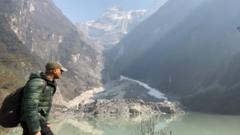Trekking in Nepal's Annapurna region used to promise breathtaking views of the majestic Himalayas, but haze now clouds the scenery, even at close range. Growing up in Kathmandu, I always marveled at the sweeping panoramas of these towering peaks. However, recent visits have shown me the harsh reality of severe air pollution forming a persistent haze that often obstructs visibility, even in traditionally clear seasons.
Last April, while on an international flight to Kathmandu, my plane had to circle the airport—a staggering twenty times—awaiting conditions conducive for landing due to the dense haze. After checking into a high-altitude hotel, I was disheartened to discover that the mountains, usually visible, remained concealed during my two-week stay. Notable vantage points like Nagarkot offered only an impenetrable wall of haze instead of spectacular mountain views.
Yogendra Shakya, who has managed a hotel in Nagarkot since 1996, lamented this change: "I no longer brand the place for views of 'sunrise, sunset, and Himalayas' as I did in the past." He has since pivoted toward promoting the region's history and culture, as the haze has diminished the appeal of its natural beauty.
Hopeful for unobstructed views while trekking in the Annapurna region during a previous trip, I found similar frustrating circumstances. Scientists indicate that the severity and duration of hazy conditions are increasing, primarily due to a concoction of pollutants including dust and smoke from fires, which lowers visibility especially in the dryer months that have extended due to climate change.
Traditionally, visitors flocked to the region from March to May and October to November, anticipating clear skies. Unfortunately, this pattern is shifting; thick haze is starting to emerge as early as December, compromising the tourism industry that thrives on stunning visuals of the Himalayas.
Lucky Chhetri, a trailblazing female trekking guide in Nepal, has noted a dramatic 40% reduction in business attributable to these hazy conditions. "In one case last year, we had to compensate a group of trekkers as our guides could not show them the Himalayas," she shared. A long-time Australian visitor lamented that not seeing these awe-inspiring formations was a "major let-down" compared to his previous trips.
Krishna KC, head of the Trekking Agents Association of Nepal in western Gandaki, echoed this sentiment, stating, "Our member trekking operators are getting depressed because no sighting of the Himalayas means no business." With business prospects dimming, some operators are contemplating different career paths altogether.
Conditions are similarly dire on the Indian side of the Himalayas, where hoteliers report denser haze returning quicker than before. "We experience long dry spells followed by heavy downpours, resulting in persistent haze," noted Malika Virdi, who manages a community-run tourism business in Uttarakhand. Despite the challenges, some tourists remain resilient, returning on multiple occasions to catch a glimpse of the elusive peaks.
In Pakistan's western Himalayas, haze hasn't disguisedly affected the mountains as significantly due to their distance from urban hubs. Yet locals acknowledged that the once-clear scenery elements are now often concealed with haze.
Regularly topping global air pollution charts, South Asian cities suffer as public health deteriorates due to the toxic air, which disrupts travel and leads to school closures. High levels of pollution stem primarily from vehicular emissions, industrial activity, and the widespread burning of waste, combined with increasing instances of forest fires and crop residue burning.
Dr. Someshwor Das from the South Asia Meteorological Association notes, "Hazes and dust storms are increasing in South Asia, and this trend is projected to continue due to climate change and other factors." A stark statistic reveals that the Pokhara airport recorded 168 hazy days in 2024, a sharp increase from just 23 hazy days in 2020.
The Himalayas, experts believe, stand as one of the worst-affected mountain ranges globally due to their location near heavily populated and polluted areas. Photographic opportunities may remain, but the firsthand experience of witnessing the subcontinent’s natural beauty could sadly become a memory of the past. "We are left to do business with guilt when we are unable to show our clients the mountains that they pay us for," Chhetri remarked, emphasizing the urgency of the situation.



















